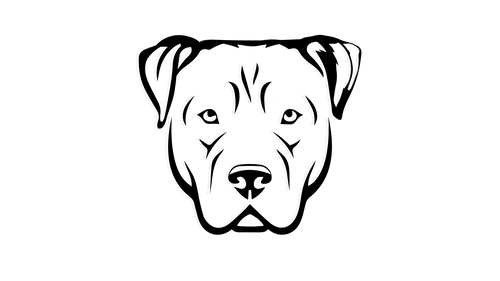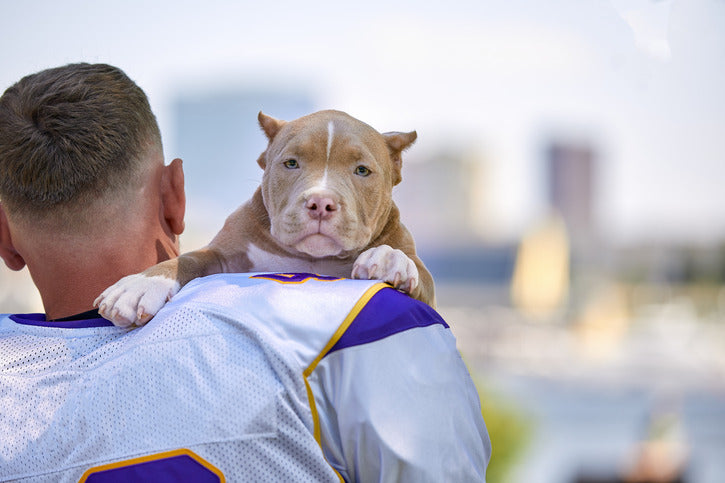Many people love the Pitbull's stocky, muscular build, but apartment life can't allow them to own one. The Pocket Pitbull is the best alternative. It has the same build appearance and playful and energetic personality as the American Pitbull Terrier, but in a smaller size that can navigate your furniture without knocking everything over. Here is all you need to know about this adorable breed, from history to grooming and training tips.
What You Need to Know About This Adorable Breed

As the name suggests, pocket pitbulls are miniature versions of American pitbull terriers. Since it's impossible to reduce the size of a purebred American pitbull terrier, the pocket pitbull shares the pitbull genes with a miniature dog to achieve its tiny size.
As a result, the size, temperament, and coat appearance of the pocket pitbull are not 100% like those of the standard pitbull. The combination of this dog's personality and physical attributes makes it so adorable and in high demand that a puppy costs anywhere between $1,500 and $2,500. This cost is way above that of an American pitbull terrier puppy, which costs around $500. Here is all about the pocket pitbull breed.
History
The Pocket Pitbull is a cross between the American Pit Bull Terrier or American Staffordshire Terrier and the Patterdale Terrier. The Pitbull brings muscle and loyalty, while the Patterdale adds feistiness and a lot of get-up-and-go. Note that some breeders use the Boston Terrier or the French Bulldog instead of the Patterdale Terrier.
American Staffordshire Terriers are known for their boundless energy and playful spirit. On the other hand, Patterdale Terriers are small enough to chase critters down burrows. The breeders aimed to combine the adorable, pint-sized frame of the Patterdale Terrier with the enthusiasm and friendliness of the American Staffordshire Terrier.
The Pocket Pitbull is a relatively new pup on the block, having only been around for 20 years. As a result, they're not officially recognized by the American Kennel Club, the United Kennel Club, the National Hybrid Registry, and the American Canine Hybrid Club.
Characteristics
Since Pocket Pitbulls are not purebred, each pup is a unique blend of their Patterdale Terrier and American Staffordshire Terrier parents. This mix-and-match means you might get a Pocket Pitbull who leans more towards one side. However, you can expect the following physical appearance attributes.
Size and Weight
Pocket Pitbulls are the mini versions of their Pitbull Terrier cousins with a serious size difference. A full-grown Pitbull Terrier weighs around 30 to 60 pounds. A full-grown Pocket Pitbull weighs around 11 to 22 pounds, about ⅓ of a Pitbull Terrier's weight. The standing height is usually 12 inches to 16 inches.
It's a weight and size that humans can comfortably carry in their arms. That's why they've earned nicknames like miniature Pitbull or teacup mini Pitbull. Any Pitbull pup that grows bigger than this range is no longer considered a Pocket Pitbull. Note that Pocket Pitbulls originated in the United Kingdom, not the United States.
Interestingly, when people in the US see small, mixed-breed dogs with some Pitbull in them, they often call them Pocket Pitbulls out of pure affection without caring about the breed standards. That means you can find some people referring to their pups as Miniature Pitbulls, even if they don't fall in the above weight and size brackets.
Appearance
Pocket Pitbulls are pint-sized, but don't let their size fool you. They inherit the same muscular build as their American Pitbull Terrier ancestors. The chest is deep and broad, and the legs and hindquarters are well-developed and muscular. The coat can have brown and white, black, gray, brindle, cream, or pied colors.
One thing that sets them apart from their bigger Pitbull cousins is their head shape. Pocket Pitbulls have a narrower muzzle and a more wedge-shaped skull. Their ears are either short or medium-sized, and if left uncropped, they flop forward or to the sides.
The eyes usually have shades of amber or brown, while their noses are brown, black, or blue. Although Pocket Pitbulls have a flatter face than dogs like Teacup Yorkies, it's not as extreme as that of Pugs. As a result, Pocket Pitbulls are considered medium-risk brachycephalic breeds.
Lifespan
On average, the Patterndale takes 14 to 16 months to mature, while the American Pitbull Terrier takes 2 to 3 years to mature. Pocket Pitbulls usually land somewhere in between, depending on the dominant genes.
So, expect them to mature anywhere from between 18 to 24 months. A healthy Pocket Pitbull has a life expectancy of around 11 to 13 years.
Temperament
The Pocket Pitbulls are a mashup of two different breeds, and their personality can be all over the place. But even with this in mind, there are some misconceptions. Some people think these dogs have some leftover drama and aggression from their Pitbull ancestors who were used in dog fighting. That is not the case.
These pups have unwavering loyalty and thrive on human connection. They are a good fit for active families where they are active participants. However, note that Pocket Pitbulls inherit a strong prey drive from their terrier and bulldog ancestry.
So, expect them to chase small, fast-moving objects, including cats, rodents, and young children. Although this seems playful, when you combine it with their territorial and protective nature, it’s not advisable to leave them with children unsupervised.
Care Requirements
The American Pitbull Terriers and the Patterdales have two completely different coats. The American Pitbull Terrier has a sleek, smooth coat without an undercoat. This single coat sheds minimally and requires less maintenance.
On the other hand, the Patternadale has a double coat. The outer coat is coarse and wiry, while the undercoat is dense. Since Pocket Pitbulls are a mixed breed, their coat can fall anywhere on this spectrum.
However, in most cases, the Pocket Pitbull coats lean closer to that of the American Pitbull Terriers. But don’t expect the coat to be as short and smooth as that of the American Pitbull Terrier. The Pocket Pitbull coat is usually low-maintenance, and you only need to brush it once a week.
Exercise Requirements
Both Pocket Pitbull parent breeds possess a strong work ethic. Patterdale Terriers were bred to tirelessly chase prey in rugged terrain, requiring exceptional stamina. American Pitbull Terriers were historically used for farm work and herding cattle, demanding high energy and athleticism.
Although small, Pocket Pitbulls inherit this energetic spirit. Aim for at least 1 hour of daily exercise. For example, you can go for walks in places like parks and trails. The good thing is that these dogs can play and run freely to relieve energy.
Just look for secure, fenced-in dog parks. You can also provide the dog with food puzzles and treat-dispensing toys to stimulate its mind and keep it engaged. Note that these dogs develop bad behaviors if you don’t provide enough exercise to use the pent-up energy.
Training
Training is key when dealing with a territorial and protective dog. The good news is that the Pocket Pitbull is a blend of two intelligent and eager-to-please breeds. Psychologist Stanley Coren, a leading researcher on canine intelligence, categorized American Staffordshire Terriers in the third tier of his dog intelligence ranking.
Note that all four pitbull breeds weren’t included in the research, so the pitbull ranking is based on the American Staffordshire Terrier. The dog proved it can learn new commands in 15 to 25 repetitions and obey them around 70% of the time.
So, the misconception that Pocket Pitbulls are dumb and are always led by their aggression is not true. Their intelligence is above average. However, their high energy and playful nature make them have short attention spans. So, keep training sessions to 5 to 10 minutes and include things that stimulate their minds and bodies.
Health
The hybrid vigor theory claims that mixed-breed animals like Pocket Pitbulls inherit a wider gene pool. As a result, mixed dog breeds have better resilience compared to purebred dogs. However, this doesn’t mean Pocket Pitbulls are immune to health issues. Here are the most common health concerns.
- Patellar luxation: It’s an orthopedic condition in small dog breeds, including Pocket Pitbulls, where the kneecap slips out of its normal groove in the knee joint. The common signs are limping and abnormal gait.
- Cerebellar abiotrophy: This is a progressive, degenerative disease that affects the cerebellum, a part of the brain responsible for balance, coordination, and smooth muscle movements. The common signs are wobbly gait, difficulty performing precision movements like ball fetching, tremors, and loss of balance.
- Intervertebral disc disease: Pocket Pitbulls, like other short-legged dog breeds, are predisposed to Intervertebral Disc Disease. As the name suggests, this condition affects the intervertebral discs. The common symptoms are yelping and whining due to back pain, tension in the back muscles, wobbly gait, and limping.
Final Thoughts
Pocket Pitbulls look more like the American Pitbull Terrier parent than the Patterdale Terrier parent. Since Pocket Pitbulls aren’t purebred, they aren’t recognized by major dog associations such as the American Kennel Club. These dogs are loyal and loving to their family members. They also have high energy levels and need rigorous exercises to prevent destructive behaviors.

